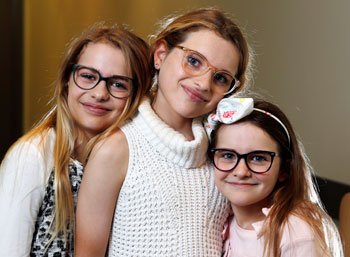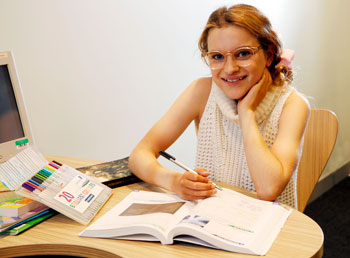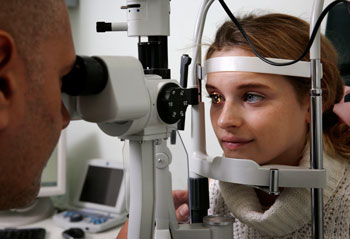Naomi Barber Undiagnosed Eye Condition in Children Interview

Undiagnosed Eye Conditions can Severely Impair a Child's Education and Wellbeing
YouTube Star Sabre Norris and Family open their eyes to kid's eye health as it's revealed 1 in 3 Australian children have never had their eyes checked.
The education and wellbeing of over a million Australian children could be at risk with as many as 1 in 4 suffering from an undiagnosed eye condition, experts at Specsavers have warned.
This comes as new research from Specsavers reveals as many as 1 in 3 Australian children have never had an eye test (32%). This is despite the recommended age for a first eye test being three years old, and that some eye conditions that can be detected during a comprehensive eye check, have no visible symptoms at all.
Specsavers Optometrist Naomi Barber says, "Vision plays an essential role in children's physical, social and educational development. While good vision is obviously important for education and learning, eye health can have wider impacts on a child's development – everything from sport to social engagement. The signs of eye conditions and sight loss can be hard to spot, often having no visible symptoms at all, so it's important we remind parents about the importance of regular eye checks."
Specsavers has teamed up with 'The Norris Nuts' to encourage parents to commit to taking their children for an eye test.
Between shooting their candid YouTube videos, surfing, skateboarding, school work and appearances on Ellen DeGeneres amongst others; YouTube sensation Sabre Norris and her family (The Norris Nuts) have personally overlooked eye health in the past.
With over a third (38%) of parents who have never taken their child for an eye test admitting they've never really thought about getting their child's eyes tested, and 31% thinking their child was too young, the Norris family wants to share their story to encourage all Australian parents to prioritise their children's eye health.
Brooke Norris, mum of Sabre and her siblings admits, "As parents who have both had eye conditions in the past, we have to confess to overlooking getting our children's eyes tested.
"It was only when I noticed Sockie's schoolwork suffering, and she'd stopped reading as much, that I thought she may have a problem. Even then, before I decided to get her eyes tested, I questioned whether it might be because of lack of motivation, disinterest or other learning problems.
"Children don't know their eye sight is suffering and because it can be something that's not physical or painful, it's hard for us as parents to see it too. Even after Sockie was prescribed glasses, we still didn't get the other kids checked straight away as they seemed fine."
 With half of Aussie parents who have not taken their child for an eye test (48%) thinking there's nothing wrong with their child's eyes, the research shows it's important that parents understand that often there can be no symptoms at all, so it's vital that a visit to an optometrist becomes part of their child's regular health checks.
With half of Aussie parents who have not taken their child for an eye test (48%) thinking there's nothing wrong with their child's eyes, the research shows it's important that parents understand that often there can be no symptoms at all, so it's vital that a visit to an optometrist becomes part of their child's regular health checks.
Together with Sockie (10), Sabre (13) has since realised she needs to wear glasses and following a family trip to Specsavers, youngest sibling Naz (6) has just been prescribed glasses too.
Sabre says, "I didn't even know there was a problem with my eyes until I tried on Sockie's glasses and everything looked so much better!
"We all went for eye tests and now Sockie, Naz and I all need glasses, but no one knew until we went to get our eyes tested."
Specsavers Optometrist Naomi Barber adds, "It's worrying to see that even today almost 1 in 3 children have still never had an eye test. Eye conditions, along with allergies and asthma, are the most common long-term health problems experienced by children. Early detection of any eye condition is critical but with children we have a window of opportunity, before they are eight years old, to identify and treat common eye conditions such as myopia (short sightedness) and lazy eye, which can have no obvious symptoms.
"Undiagnosed eye conditions in children, like myopia, can severely impair a child's education and wellbeing. Our research found that as many as 1 in 5 parents are unaware that learning difficulties can often be a result of poor eyesight caused by an eye condition. This can be especially true for young children, who may find it hard to explain the difficulties they are experiencing or may be unaware they have a problem at all, making tests at a young age even more critical."
Specsavers Optometrist Naomi Barber continues, "We want to encourage parents to get their own eyes and their child's eyes tested, not just to check for any potential vision problems, but also to detect any potential abnormalities or diseases before it's too late.
"Prevention is better than cure. We recommend children have their eyes checked every two years, and at Specsavers comprehensive eye checks are bulk billed*."
 Interview with Naomi Barber, Specsavers Optometrist
Interview with Naomi Barber, Specsavers Optometrist
Question: How do undiagnosed eye conditions affect our children?
Naomi Barber: Vision plays an essential role in a child's physical, social and educational development. While good vision is obviously important for education and learning, eye health has wider impacts on a child's development – everything from sport and social engagement, to job prospects into adulthood.
Question: What types of eye conditions are undiagnosed in Australian children? What are some of the common eye conditions of children?
Naomi Barber: Up to 1 in 20 children develop a turned eye, or squint before the age of five. This occurs commonly due to muscle dysfunction and long-sightedness. A child will sometimes be experiencing blurred or double vision however, these symptoms are often not able to be explained by children as they have no comparison to 'normal' vision.
Long-sightedness (hyperopia) and short-sightedness (myopia) are also common eye conditions we see in children that can be easily corrected with glasses. Young children affected by these conditions often come to an optometrist with few or no symptoms. However, symptoms tend to become more evident after a child has started school due to the increase in focused tasks. We recommend that children have routine eye tests regardless of whether they are experiencing symptoms. It is of much greater benefit to proactively treat these conditions before a child begins at school so as not to disrupt their learning.
Astigmatism is another common eye condition that can cause blurred or distorted vision and requires correction with glasses. Left untreated, astigmatism can cause headaches, eye strain and tiredness.
It is crucial that childhood eye conditions are detected and managed early, as they become harder to treat with age. The best results are seen when management is initiated before the age of 5. In most cases, if detected early, these eye conditions can be successfully managed by an optometrist and/or paediatric eye specialist to ensure the eyes are straight and there is minimal or no loss of vision in the weaker eye.
Question: Can you talk us through the signs parents need to look out for regarding eye health in their children?
Naomi Barber: Whilst some eye conditions may have no symptoms, there are some common signs that parents can look out for. Eye conditions can affect their wellbeing and development with children often falling behind in school as a result of poor eyesight.
Parents should ask themselves, have they started to avoid activities which require near focus such as reading and device-related activities? Are they sitting very close to the TV, or squinting, closing one eye or tilting their heads to see read signs or see things in the distance? When reading, they may lose their place or need to use their fingers as a guide with very slow tracking across the page. They may also be overly sensitive to light or experience excessive tearing in bright conditions, or demonstrate excessive eye rubbing. These are all signs that your child should have an eye test.
However, more often than not symptoms aren't obvious or easy for children to explain, which is why it's important to take your child for a routine eye test regardless of whether they are experiencing symptoms.
Question: At what age and how frequently do children need to be having their eyes tested?
Naomi Barber: Many childhood eye conditions can be effectively managed if caught early, we recommend taking children for their first eye test at the age of 3 and regularly every 2 years thereafter. Children's eyes continually change as they develop which is why they should be carefully monitored.
 Question: What is involved in a children's eye test at Specsavers?
Question: What is involved in a children's eye test at Specsavers? Naomi Barber: There are various specialised techniques optometrists use in order to thoroughly assess children's eyes. These techniques mean that accurate results can be obtained without too much reliance on the child to respond or articulate what they are seeing, allowing for the eye test to be conducted quickly and in a way that makes children feel comfortable and at ease. We use specially designed charts that allow children to recognise shapes or pictures for children who are not yet confident with their alphabet.
Question: How early can abnormalities or diseases be detected during an eye-test?
Naomi Barber: Optometrists tailor the eye test for the patient's age. For pre-school aged children the eye test consists of a series of screening tests which are used to understand whether the child's eyes are functioning normally for their age. In cases where an eye condition is found the child can then be managed appropriately. This may be management and monitoring by an optometrist, or referral on to a paediatric eye specialist if required.
Have You Seen This?
MORE








